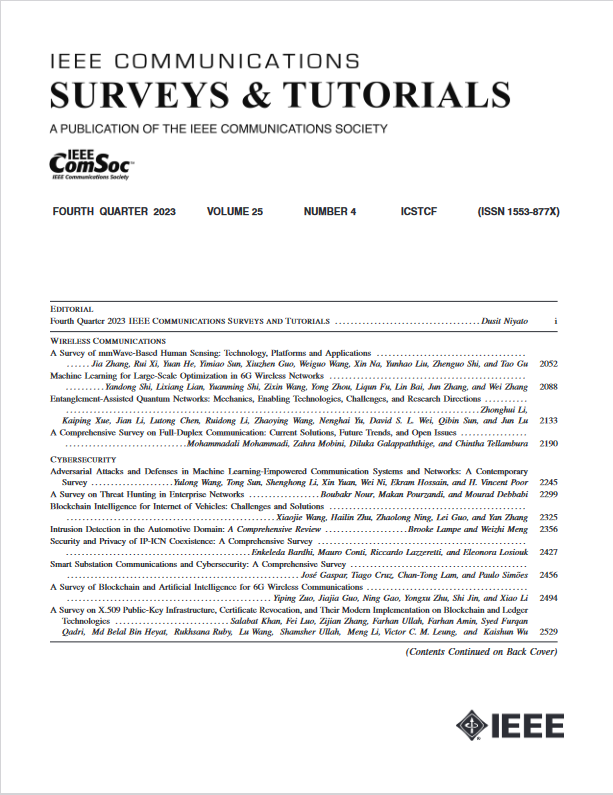人工智能增强型云端端协作网络:调查、应用和未来方向
IF 34.4
1区 计算机科学
Q1 COMPUTER SCIENCE, INFORMATION SYSTEMS
引用次数: 0
摘要
云-边缘-终端协作网络(CETCN)因其在提供低延迟和超可靠计算服务方面的巨大潜力,被视为新兴应用的一种新模式。然而,由于终端设备的异构计算能力和 CETCN 面临的复杂环境,实现这些优势非常具有挑战性。特别是,高维和动态的环境状态给 CETCN 在任务卸载、协作缓存和移动性管理方面做出高效决策造成了困难。为此,人工智能(AI),特别是深度强化学习(DRL)已被证明能有效解决各种领域的连续决策问题,并为上述问题提供了一种前景广阔的解决方案,原因有以下几点。首先,基于 DRL 的方法不需要对 CETCN 进行精确建模,而这在实际应用中很难实现。其次,通过与环境的迭代交互,DRL 可以有效应对高维动态任务。第三,由于任务的复杂性和不同供应商之间资源供应的差异,不同供应商之间需要协作完成任务。多代理 DRL(MADRL)方法在解决协作任务方面非常有效,协作任务可以由不同厂商提供的云、边缘和终端设备共同完成。本调查全面概述了 DRL 和 MADRL 在 CETCN 中的应用。调查的第一部分深入概述了 CETCN 的关键概念以及 DRL 和 MADRL 的数学基础。然后,我们重点介绍了 RL 算法在解决 CETCN 中各种挑战方面的应用,如任务卸载、资源分配、缓存和移动性管理。此外,我们将讨论扩展到探讨 DRL 和 MADRL 如何在智能交通系统 (ITS)、工业物联网 (IIoT)、智能健康和数字农业等新兴 CETCN 场景中取得进展。此外,我们还讨论了与在 CETCN 中应用 DRL 相关的安全考虑因素,并概述了与边缘智能相关的现有标准。最后,我们列举了在这一不断发展的领域中汲取的若干经验教训,并概述了对 CETCN 发展至关重要的未来研究机遇和挑战。我们希望这份调查报告能吸引更多的研究人员为 CETCN 的设计研究可扩展和分散的人工智能算法。本文章由计算机程序翻译,如有差异,请以英文原文为准。
AI-Enhanced Cloud-Edge-Terminal Collaborative Network: Survey, Applications, and Future Directions
The cloud-edge-terminal collaborative network (CETCN) is considered as a novel paradigm for emerging applications owing to its huge potential in providing low-latency and ultra-reliable computing services. However, achieving such benefits is very challenging due to the heterogeneous computing power of terminal devices and the complex environment faced by the CETCN. In particular, the high-dimensional and dynamic environment states cause difficulties for the CETCN to make efficient decisions in terms of task offloading, collaborative caching and mobility management. To this end, artificial intelligence (AI), especially deep reinforcement learning (DRL) has been proven effective in solving sequential decision-making problems in various domains, and offers a promising solution for the above-mentioned issues due to several reasons. Firstly, accurate modelling of the CETCN, which is difficult to obtain for real-world applications, is not required for the DRL-based method. Secondly, DRL can effectively respond to high-dimensional and dynamic tasks through iterative interactions with the environment. Thirdly, due to the complexity of tasks and the differences in resource supply among different vendors, collaboration is required between different vendors to complete tasks. The multi-agent DRL (MADRL) methods are very effective in solving collaborative tasks, where the collaborative tasks can be jointly completed by cloud, edge and terminal devices which provided by different vendors. This survey provides a comprehensive overview regarding the applications of DRL and MADRL in the context of CETCN. The first part of this survey provides a depth overview of the key concepts of the CETCN and the mathematical underpinnings of both DRL and MADRL. Then, we highlight the applications of RL algorithms in solving various challenges within CETCN, such as task offloading, resource allocation, caching and mobility management. In addition, we extend discussion to explore how DRL and MADRL are making inroads into emerging CETCN scenarios like intelligent transportation system (ITS), the industrial Internet of Things (IIoT), smart health and digital agriculture. Furthermore, security considerations related to the application of DRL within CETCN are addressed, along with an overview of existing standards that pertain to edge intelligence. Finally, we list several lessons learned in this evolving field and outline future research opportunities and challenges that are critical for the development of the CETCN. We hope this survey will attract more researchers to investigate scalable and decentralized AI algorithms for the design of CETCN.
求助全文
通过发布文献求助,成功后即可免费获取论文全文。
去求助
来源期刊

IEEE Communications Surveys and Tutorials
COMPUTER SCIENCE, INFORMATION SYSTEMS-TELECOMMUNICATIONS
CiteScore
80.20
自引率
2.50%
发文量
84
审稿时长
6 months
期刊介绍:
IEEE Communications Surveys & Tutorials is an online journal published by the IEEE Communications Society for tutorials and surveys covering all aspects of the communications field. Telecommunications technology is progressing at a rapid pace, and the IEEE Communications Society is committed to providing researchers and other professionals the information and tools to stay abreast. IEEE Communications Surveys and Tutorials focuses on integrating and adding understanding to the existing literature on communications, putting results in context. Whether searching for in-depth information about a familiar area or an introduction into a new area, IEEE Communications Surveys & Tutorials aims to be the premier source of peer-reviewed, comprehensive tutorials and surveys, and pointers to further sources. IEEE Communications Surveys & Tutorials publishes only articles exclusively written for IEEE Communications Surveys & Tutorials and go through a rigorous review process before their publication in the quarterly issues.
A tutorial article in the IEEE Communications Surveys & Tutorials should be designed to help the reader to become familiar with and learn something specific about a chosen topic. In contrast, the term survey, as applied here, is defined to mean a survey of the literature. A survey article in IEEE Communications Surveys & Tutorials should provide a comprehensive review of developments in a selected area, covering its development from its inception to its current state and beyond, and illustrating its development through liberal citations from the literature. Both tutorials and surveys should be tutorial in nature and should be written in a style comprehensible to readers outside the specialty of the article.
 求助内容:
求助内容: 应助结果提醒方式:
应助结果提醒方式:


